The Emerging Leaders in Environmental and Energy Policy (ELEEP) Network brings together young professionals from Europe and North America with the aim of fostering transatlantic relations. Former EGU Science Communications Fellow and ELEEP member Edvard Glücksman describes a study visit to Hamburg’s Wilhelmsburg borough, an unlikely leader in within Germany’s energy transition. This is his final post from the trip, which also included visits to the energy self-sufficient village of Feldheim and to Warsaw, for the COP19 climate change conference.
Winter storms and floods are common along Europe’s coastline, but the memory of some remains long after the final waters recede. In Hamburg, for example, citizens are continuously reminded of the legendary 16 February 1962, the night a powerful flood unexpectedly enveloped their city. In what is known locally as the Great Flood, the Elbe River broke through its dyke system and submerged nearly one-fifth of Germany’s second largest city’s municipal areas, collapsing infrastructure and killing 315 people.
One of the city’s most damaged areas was the heavily populated borough of Wilhelmsburg, Europe’s largest river island, reduced that night to a stagnant backwater for decades thereafter. As the handful of remaining residents struggled to pry back their lives from the river, nobody would have imagined that, just half a century later, their neighbourhood would become a thriving cosmopolitan centre, home to docks, industry, green oases and over 50,000 inhabitants.
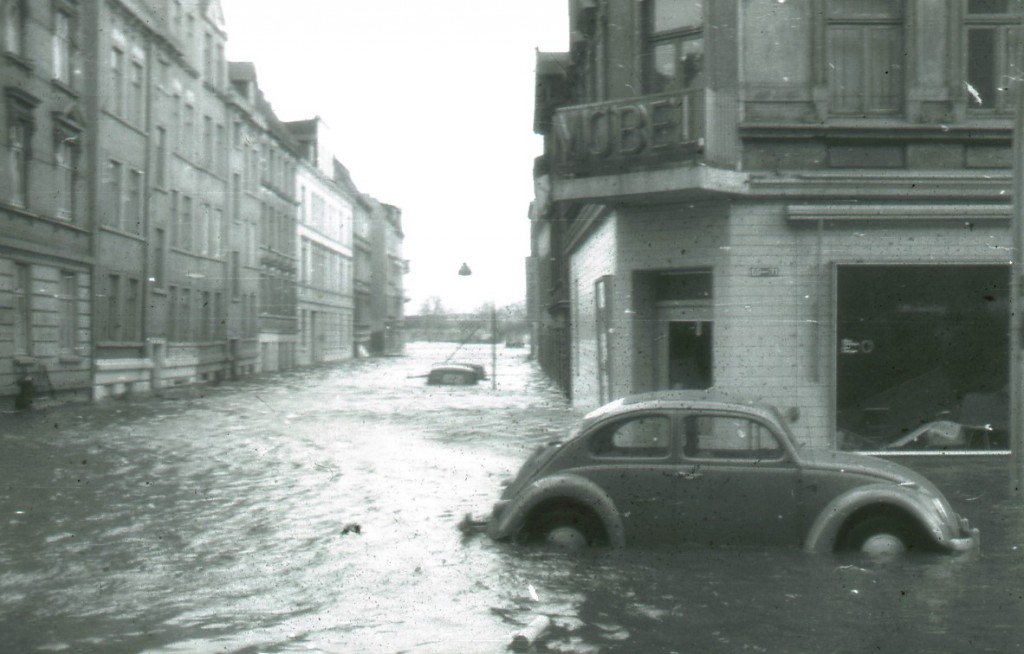
Hamburg’s Wilhelmsburg borough deep underwater after the famous flood of 1962. The recovery took decades. (Credit: Gerhard Pietsch)
In fact, the Wilhelmsburg of today is at the forefront of Germany’s energy transformation (‘Energiewende’), the planet’s most ambitious nationwide commitment to a future powered almost entirely by renewables. Like the energy self-sufficient village of Feldheim and Berlin’s Energy Plus house, the borough is a microcosm of decentralised low-carbon living. Yet unlike these prototype projects, largely new creations, Wilhelmsburg impresses by sprinkling the optimism of a renewable energy future over areas historically blighted by war, industrial mismanagement and the wrath of nature.
On the final stop of our trip we visited the International Building Exhibition (IBA Hamburg) centre, a major driving force behind Wilhelmsburg’s formidable urban development. The IBA project, a real-world experiment in multicultural, sustainable living, stretches across Wilhelmsburg and on the neighbouring island of Veddel. The area comprises a total of 70 projects, urban space and building prototypes built up and offered to tenants for everyday living. The project is powered by previously dilapidated infrastructure retrofitted with the latest low-carbon energy generation, storage, and distribution technology. Of these, two projects capture the imagination, for their energy manufacturing capabilities but also for their particular place within the context of Hamburg’s inspirational rebirth.
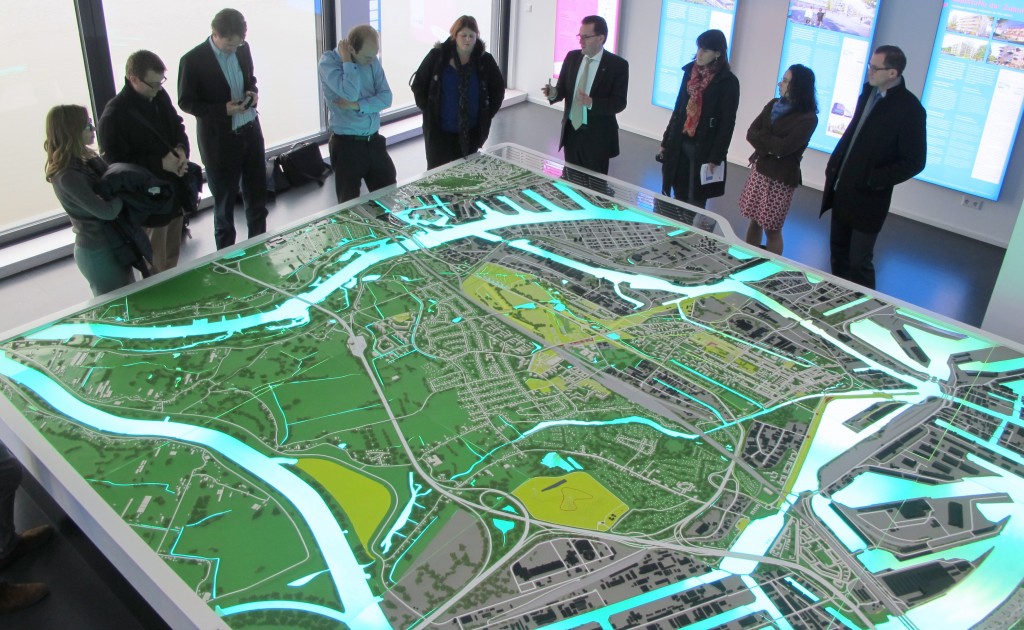
ELEEP members scrutinise the layout of Wilhelmsburg at the IBA Hamburg media centre. (Credit: Edvard Glücksman)
Energy generation and storage – with a view
On 25 August 1940, the RAF launched its first raid on Berlin in retaliation for the German bombing of London the previous day. As an immediate response, Hitler ordered the construction of a series of massive above-ground bunkers, known as flak towers, to house radar equipment and anti-aircraft guns, also providing shelter for tens of thousands of civilians across Berlin, Vienna, and Hamburg. With up to 4 m thick cement walls, the towers were virtually indestructible and Allied forces had to strategically work around them, ultimately sending in envoys to guarantee their submission.
After the war, these impenetrable fortresses remained standing, empty, ugly, and a brutal reminder of the German war machine. Some have since been renovated and opened up for public tours, offering a glimpse of the cramped and squalid conditions endured by so many during the latter years of WWII. Others have been completely refurbished, turned into entertainment venues and even nightclubs.
The Flakturm VI bunker, hastily erected in 1943 in Wilhelmburg’s Reiherstieg district, has undergone an even more radical transformation, from Nazi stronghold and shelter housing over 30,000 citizens, to a futuristic flagship structure of the IBA Hamburg exhibition.
We visited Flakturm VI, known as the ‘Energy Bunker’, just months after its unveiling. The once imposing eyesore, derelict since the British army gutted most of its interior after the war, now houses state-of-the-art energy generation and storage facilities aiming to reduce local annual carbon emissions by around 95%, or 6,600 tonnes of carbon per year.
Underneath the bunker’s cement exterior lays a complex low-emissions power and heating plant. The building is fitted with a photovoltaic shell: a rooftop solar thermal unit generating heat, and a south-facing system of solar panels producing electricity. Energy and heat are also produced by an in-house biogas ‘combined heat and power’ (CHP) plant. Through a clever siphoning system, waste heat from a neighbouring industrial plant is also co-opted by the bunker and fed into the heating grid, alongside heat derived from the building’s own wood chip burning facility. The 39-metre-high bunker also accommodates a massive 2,000 m³ water-based heat storage facility, which buffers the daily fluctuations characteristic of renewable energy sources.
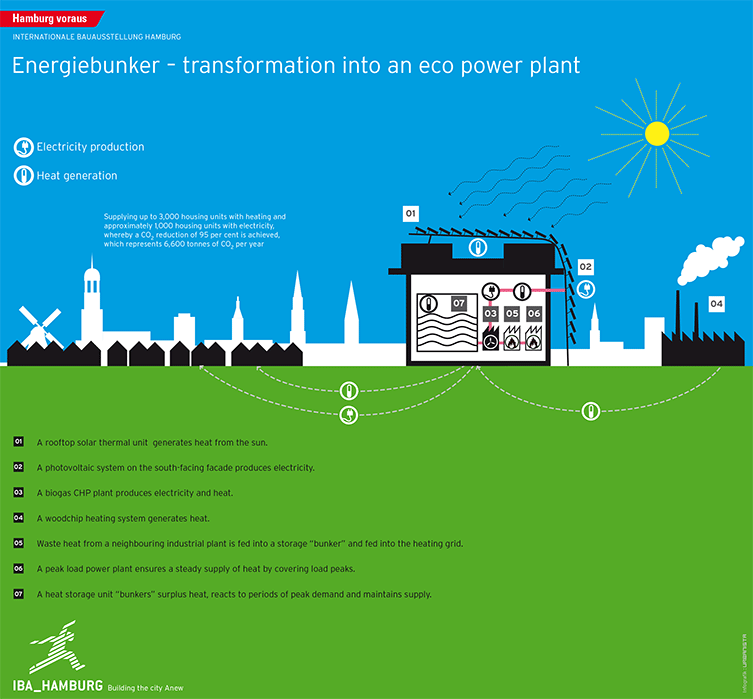
Electricity and heat production in the Energy Bunker (click to enlarge). (Credit: IBA Hamburg)
The resulting products supply most of the surrounding district with carbon-neutral heating whilst at the same time feeding electricity into the local grid. At peak use, the bunker will generate approximately 22,500 megawatt hours of heat and 3,000 megawatt hours of electricity, enough to heat and power roughly 3,000 and 1,000 local homes respectively.
With its historical exhibition and rooftop café (Café Vju), the Energy Bunker is a truly impressive project, and is the result of major local and European investment. Launched in 2006 and officially opened on 23 March 2013, the building’s refurbishment cost €27 million, of which €11.7 alone was spent on the technology and heating network. It was jointly funded by the European Regional Development Fund and the Hamburg Climate Action Plan, which aims to shore up the city’s future commitment to climate protection.
Peak efficiency on a disused landfill
We continued along our tour with a climb up the Georgswerder ‘Energy Hill’ (‘Energieberg’), another of IBA Hamburg’s flagship low-carbon redevelopment projects. As we clambered atop its green slopes, amidst wind turbines churning out renewable energy and with views over all of Hamburg, it was impossible to imagine that the 44-hectare site was a landfill for much of the post-war era.
Indeed, for decades, Georgswerder was gorged to the brink with rubble and domestic waste, and served as a clay pit for brick-making. Worse still, from 1967-74, the landfill was also used as Hamburg’s primary industrial waste dump, accumulating highly poisonous remains of lacquer and paint until it was officially closed in 1979. In total, 14 million m³ of waste material was deposited at the site, forming an imposing pile over 40 m high. Crammed full of household garbage and toxins, the hill had by then been shut off to the public for decades. And the worst was still to come.
In 1983, it was discovered that highly toxic dioxins were leaching into the groundwater, prompting a lengthy and expensive clean-up campaign. The site was dried, sealed with a plastic sheet, and covered in topsoil, and any remaining seepage water was collected, purified, and drained.
A few years later, a local working group of experts and residents combined forces and decided to, almost literally, turn the rubbish pile into a long-lasting source of renewable energy. Two generations of wind turbines were erected at the hill’s summit and, more recently, its south-facing slope was covered in photovoltaics. Even the hill’s rotting core is tapped: the methane released through decomposition is collected and used by a nearby copper smelting company.
Today, the site’s photovoltaic system and wind turbines generate approximately 12,200 megawatt hours per year, enough to power around 4,000 households.
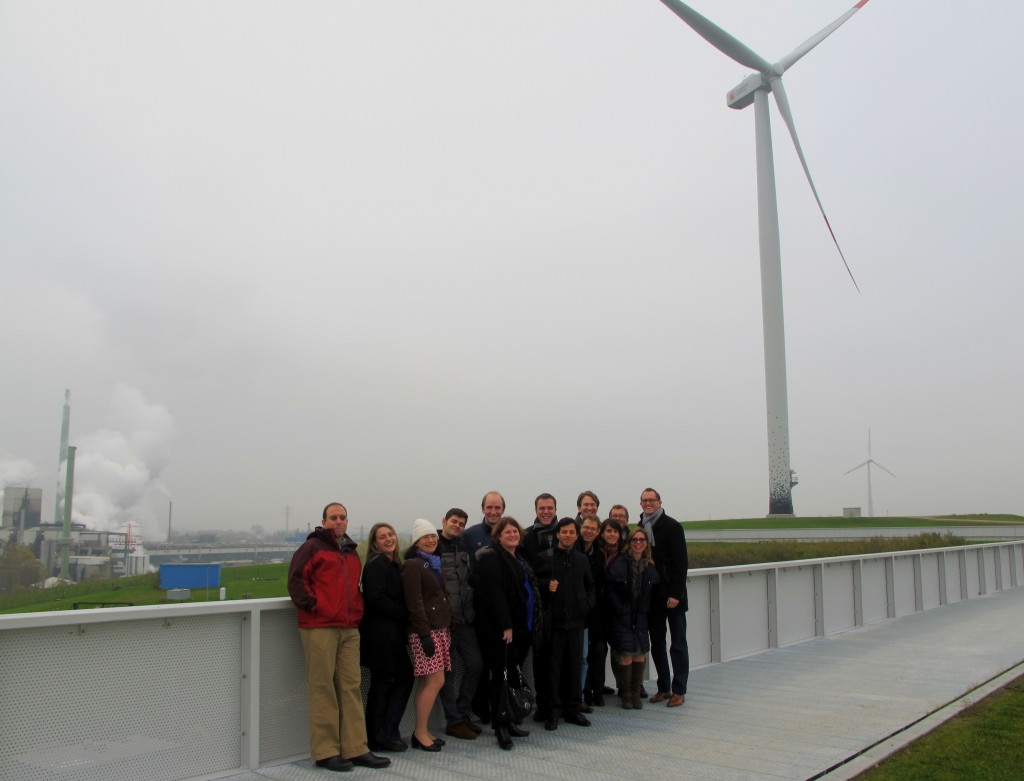
Georgswerder ‘Energy Hill’: ELEEPers admire the view on what used to be a landfill and toxic waste dump. (Credit: Edvard Glücksman)
Investing in acceptance
Hamburg is amassing green credentials and growing increasingly bolder as it plans for the future. Stefan Schurig of the World Future Council described to us the city’s emergence on the frontline of Germany’s energy transition, which hinges on a widespread acceptance for low-emissions projects at the community, socio-political, and marketplace levels. The shifting public perception of carbon-neutral infrastructure, from NIMBYs (“not in my back yard”) to PIMBYs (“please, in my back yard”), is therefore a vital first step in developing the country’s energy strategy. Participation triggers acceptance and, Schurig claims, acceptance triggers investment.
In Wilhelmsburg, life has never been so good. As a result, the IBA Hamburg sites we visited, though restricted to a single locality, are widely accepted by the community. Specifically, the Energy Bunker and Hill demonstrate that dilapidated infrastructure can, with some initial investment, be turned into long-term zero-emissions sources of energy and heating. Such projects guide Germany’s progression towards fulfilling the remarkable energy portfolio shift it proposes: decentralised yet scalable, flexible yet reliable; and, above all, profitable. As public support grows, further investment will surely follow.
By Edvard Glücksman, Postdoctoral Research Fellow, University of Duisburg-Essen
ELEEP is a collaborative venture between two non-partisan think tanks, the Atlantic Council and Ecologic Institute, seeking to develop innovative transatlantic policy partnerships. Funding was initially acquired from the European Union’s I-CITE Project and subsequently from the European Union and the Robert Bosch Stiftung. ELEEP has no policy agenda and no political affiliation.

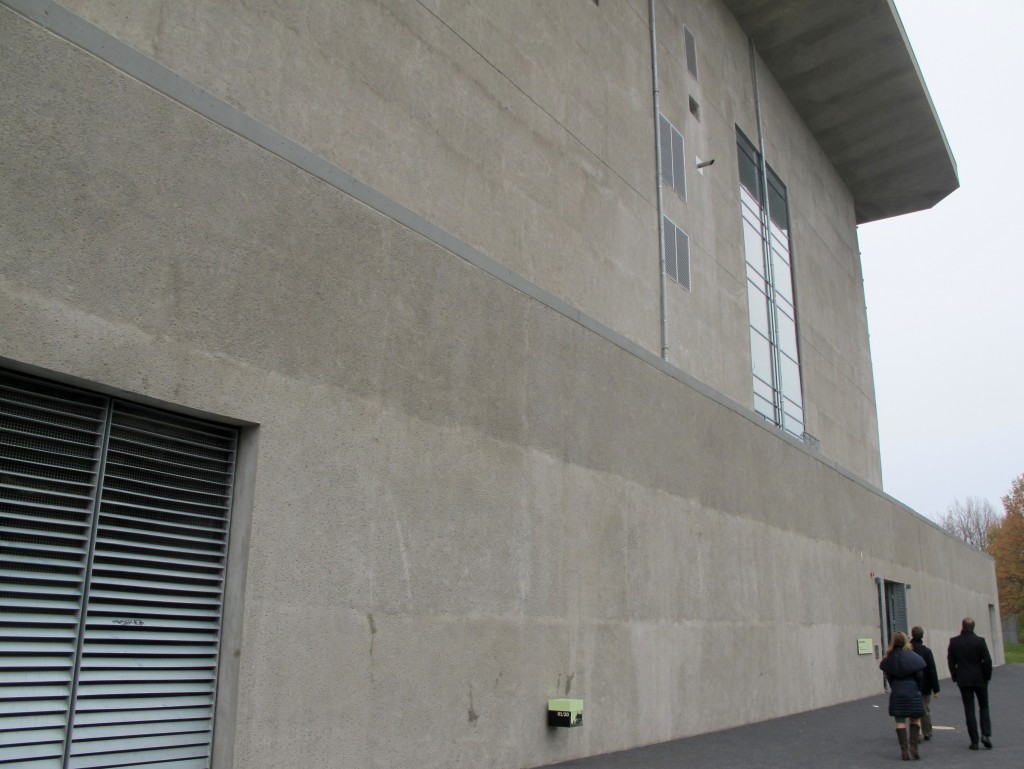



Pingback: GeoLog | Counterintuitive solutions improve public transportation and urban design in Seattle
Pingback: GeoLog | Climate-proofing the Netherlands